Electro Harmonix POG Handleiding
Bekijk gratis de handleiding van Electro Harmonix POG (2 pagina’s), behorend tot de categorie Niet gecategoriseerd. Deze gids werd als nuttig beoordeeld door 264 mensen en kreeg gemiddeld 4.3 sterren uit 132.5 reviews. Heb je een vraag over Electro Harmonix POG of wil je andere gebruikers van dit product iets vragen? Stel een vraag
Pagina 1/2

THE POG
Polyphonic Octave Generator
Congratulations on your purchase of the POG! The POG is a Polyphonic Octave Generator. What
does that mean exactly? Well, the POG can simultaneously generate multiple octaves from your
input signal. Whether you play single notes, arpeggios or full chords, the POG will track every
note you play. With the POG, you can mix together your original "dry signal" with three different
octaves -- one above, two above, and one below your original note. You can also mix detuned
versions of both the +1 Octave and +2 Octaves. At the end of the chain is a Low Pass Filter to
further tailor your sound.
-CONTROLS-
INPUT Slider – Controls the amplitude of the INPUT signal before entering the A/D converter.
The gain increases as the slider is pushed upward.
DRY OUTPUT Slider – Controls the output volume of your original, unaffected DRY signal before
it exits the POG. The DRY OUTPUT volume will increase as this slider is pushed upward.
SUB OCTAVE Slider – Controls the output volume of the SUB OCTAVE signal. The SUB OCTAVE
is one octave below the original input signal, which is half the frequency of the input signal. As
this slider is pushed upward, the volume of the SUB OCTAVE will increase.
+1 OCTAVE Slider – Controls the output volume of the +1 OCTAVE signal. True to its name,
the +1 OCTAVE signal is one octave above the original input signal. The +1 OCTAVE signal is
twice the frequency of the original input signal. The volume of the +1 OCTAVE will increase as
this slider is pushed upward.
+1 OCTAVE DETUNED Slider – Controls the output volume of the +1 OCTAVE DETUNED signal.
This signal is a modulated, detuned version of the +1 Octave signal. The frequency of the +1
OCATVE DETUNED signal is modulated at a fixed rate above and below the frequency of the
original +1 Octave signal. The volume of the +1 OCTAVE DETUNED signal will increase as this
slider is pushed upward. Mixing the +1 OCTAVE DETUNED signal along with the dry signal will
yield a 12-string guitar sound from one 6-string guitar.
+2 OCTAVE Slider – Controls the output volume of the +2 OCTAVE signal. The +2 Octave
signal is two octaves above the original input signal or four times the frequency of the original
input signal. As this slider is pushed upward, the volume of the +2 OCTAVE signal will increase.
+2 OCTAVE DETUNED Slider – Controls the output volume of the +2 OCTAVE DETUNED signal.
This signal is a modulated, detuned version of the +2 Octave signal. The frequency of the +2
Octave Detuned signal is modulated at a fixed rate above and below the frequency of the
original +2 Octave signal. The volume of the +2 OCTAVE DETUNED signal will increase as this
slider is pushed upward. Mixing the +2 OCTAVE DETUNED signal with the +1 OCTAVE
DETUNED signal and the dry signal will yield an 18-string guitar sound from one 6-string guitar.
LP FILTER Slider – Controls the cutoff frequency of the Low Pass Filter. As the LP FILTER slider
is pushed upward, the cutoff frequency of the filter rises. All of the generated octave signals go
through the LP Filter. The dry signal either bypasses the LP Filter or goes through it, depending
on the setting of the LPF MODE switch (see below).
LPF MODE Slide Switch – This switch selects between three possible modes for the LP Filter.
These modes are detailed below:
WARNING:
Use only the 18VDC/500mA AC adapter the POG comes supplied with. Do not
use any other AC adapters. Using other AC adapters, even those made by Electro-Harmonix,
could cause harm to the unit, the adapter or you. The POG does not use batteries.

MODE 1: The Dry signal bypasses the LPF. The Q of the LPF is set to 1, low Q.
MODE 2: The Dry signal goes through the LPF. The Q of the LPF is set to 1.
MODE 3: The Dry signal goes through the LPF. The Q of the LPF is increased to 2.
sTATUS LED – This LED indicates the current state of the unit. When the LED is lit up, the box
is in effect mode. When the LED is off, the box is in TRUE BYPASS mode. The POG will always
start up in bypass mode.
INPUT Jack – This ¼” jack is the audio input to the POG.
OUTPUT Jack – This ¼” jack is the audio output from the POG. When the POG is in bypass
mode, the OUTPUT jack is connected directly to the INPUT jack.
- OPERATION NOTES -
Here are some fun sounds we came up with while developing the POG. They can all be
seasoned to your own tastes.
12-string Guitar – Turn your 6-string into a 12. Set all of the sliders to 0. Bring up the INPUT
slider to about 40%. Set the DRY and LP FILTER sliders to their maximum positions. Bring +1
OCTAVE DETUNED up to about 70%. Set the LPF MODE switch to Mode 2. For an 18-string
guitar, raise the +2 OCTAVES DETUNED to 75%.
Phat Bass – Turn your guitar into a great sounding bass. Set all of the sliders to 0. Turn the
INPUT slider up to 50-75%. Set the SUB OCTAVE slider to its maximum position. Bring the LP
FILTER slider up to about 25%. Put the LPF MODE switch into Mode 3. Works best with low
notes on the guitar.
Organ – Turn your guitar into an organ. Set the INPUT slider up to about 50%. Bring the DRY,
SUB OCTAVE and +1 OCTAVE sliders up to their maximum positions. Set the +1 OCTAVE
DETUNED slider to about 75%. Bring the +2 OCTAVE slider up to about 80%. Set both the +2
OCTAVES DETUNED and the LP FILTER sliders to about 50%. Set the LPF MODE switch to
MODE 2. Works best with sustained chords.
Product specificaties
| Merk: | Electro Harmonix |
| Categorie: | Niet gecategoriseerd |
| Model: | POG |
Heb je hulp nodig?
Als je hulp nodig hebt met Electro Harmonix POG stel dan hieronder een vraag en andere gebruikers zullen je antwoorden
Handleiding Niet gecategoriseerd Electro Harmonix
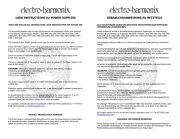
5 Augustus 2025
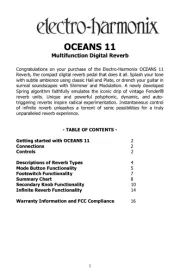
5 Augustus 2025
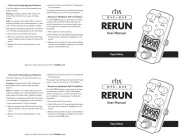
5 Augustus 2025
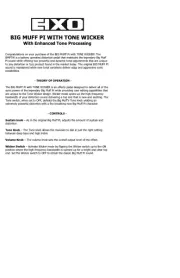
5 Augustus 2025
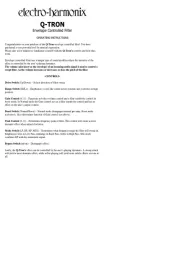
5 Augustus 2025
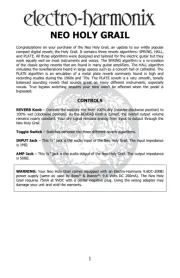
4 Augustus 2025
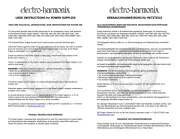
4 Augustus 2025
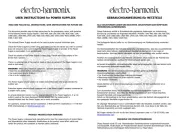
4 Augustus 2025
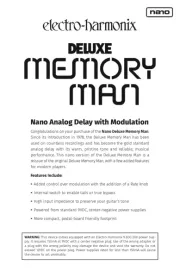
4 Augustus 2025
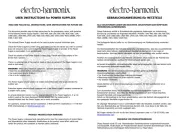
4 Augustus 2025
Handleiding Niet gecategoriseerd
- Peak Design
- Listen
- Steelbody
- OOONO
- UX
- Infomir
- Arendo
- Symmons
- Arista
- Powr-Flite
- Rexing
- Metro
- Icom
- EVOline
- Monitor Audio
Nieuwste handleidingen voor Niet gecategoriseerd

14 September 2025

14 September 2025

13 September 2025

13 September 2025

13 September 2025

13 September 2025

13 September 2025

13 September 2025

13 September 2025

13 September 2025